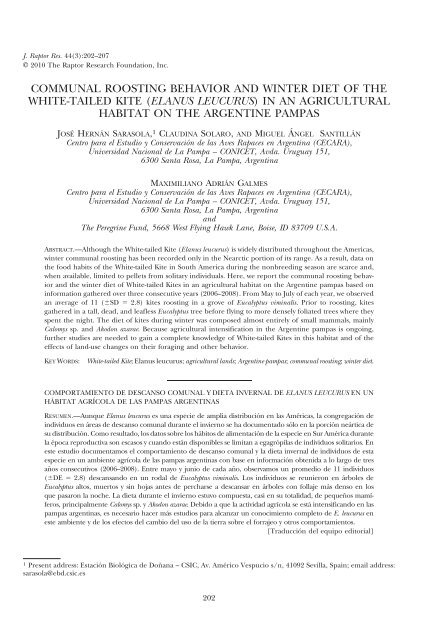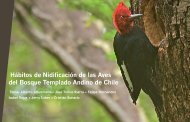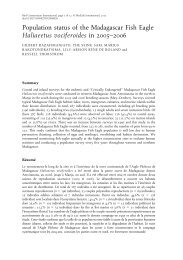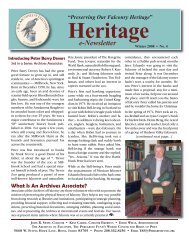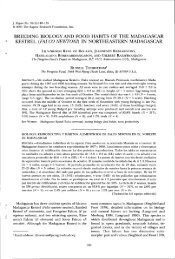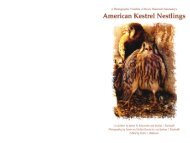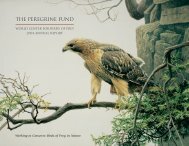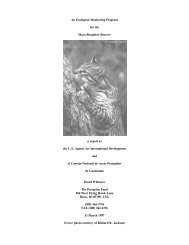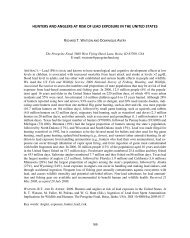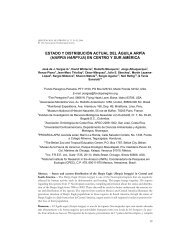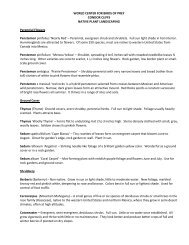communal roosting behavior and winter diet of the white-tailed kite
communal roosting behavior and winter diet of the white-tailed kite
communal roosting behavior and winter diet of the white-tailed kite
Create successful ePaper yourself
Turn your PDF publications into a flip-book with our unique Google optimized e-Paper software.
J. Raptor Res. 44(3):202–207<br />
COMMUNAL ROOSTING BEHAVIOR AND WINTER DIET OF THE<br />
WHITE-TAILED KITE (ELANUS LEUCURUS) IN AN AGRICULTURAL<br />
HABITAT ON THE ARGENTINE PAMPAS<br />
JOSÉ HERNÁN SARASOLA, 1 CLAUDINA SOLARO, AND MIGUEL ÁNGEL SANTILLÁN<br />
Centro para el Estudio y Conservación de las Aves Rapaces en Argentina (CECARA),<br />
Universidad Nacional de La Pampa – CONICET, Avda. Uruguay 151,<br />
6300 Santa Rosa, La Pampa, Argentina<br />
MAXIMILIANO ADRIÁN GALMES<br />
Centro para el Estudio y Conservación de las Aves Rapaces en Argentina (CECARA),<br />
Universidad Nacional de La Pampa – CONICET, Avda. Uruguay 151,<br />
6300 Santa Rosa, La Pampa, Argentina<br />
<strong>and</strong><br />
The Peregrine Fund, 5668 West Flying Hawk Lane, Boise, ID 83709 U.S.A.<br />
ABSTRACT.—Although <strong>the</strong> White-<strong>tailed</strong> Kite (Elanus leucurus) is widely distributed throughout <strong>the</strong> Americas,<br />
<strong>winter</strong> <strong>communal</strong> <strong>roosting</strong> has been recorded only in <strong>the</strong> Nearctic portion <strong>of</strong> its range. As a result, data on<br />
<strong>the</strong> food habits <strong>of</strong> <strong>the</strong> White-<strong>tailed</strong> Kite in South America during <strong>the</strong> nonbreeding season are scarce <strong>and</strong>,<br />
when available, limited to pellets from solitary individuals. Here, we report <strong>the</strong> <strong>communal</strong> <strong>roosting</strong> <strong>behavior</strong><br />
<strong>and</strong> <strong>the</strong> <strong>winter</strong> <strong>diet</strong> <strong>of</strong> White-<strong>tailed</strong> Kites in an agricultural habitat on <strong>the</strong> Argentine pampas based on<br />
information ga<strong>the</strong>red over three consecutive years (2006–2008). From May to July <strong>of</strong> each year, we observed<br />
an average <strong>of</strong> 11 (6SD 5 2.8) <strong>kite</strong>s <strong>roosting</strong> in a grove <strong>of</strong> Eucalyptus viminalis. Prior to <strong>roosting</strong>, <strong>kite</strong>s<br />
ga<strong>the</strong>red in a tall, dead, <strong>and</strong> leafless Eucalyptus tree before flying to more densely foliated trees where <strong>the</strong>y<br />
spent <strong>the</strong> night. The <strong>diet</strong> <strong>of</strong> <strong>kite</strong>s during <strong>winter</strong> was composed almost entirely <strong>of</strong> small mammals, mainly<br />
Calomys sp. <strong>and</strong> Akodon azarae. Because agricultural intensification in <strong>the</strong> Argentine pampas is ongoing,<br />
fur<strong>the</strong>r studies are needed to gain a complete knowledge <strong>of</strong> White-<strong>tailed</strong> Kites in this habitat <strong>and</strong> <strong>of</strong> <strong>the</strong><br />
effects <strong>of</strong> l<strong>and</strong>-use changes on <strong>the</strong>ir foraging <strong>and</strong> o<strong>the</strong>r <strong>behavior</strong>.<br />
KEY WORDS:<br />
White-<strong>tailed</strong> Kite; Elanus leucurus; agricultural l<strong>and</strong>s; Argentine pampas; <strong>communal</strong> <strong>roosting</strong>; <strong>winter</strong> <strong>diet</strong>.<br />
E 2010 The Raptor Research Foundation, Inc. 202<br />
COMPORTAMIENTO DE DESCANSO COMUNAL Y DIETA INVERNAL DE ELANUS LEUCURUS EN UN<br />
HÁBITAT AGRÍCOLA DE LAS PAMPAS ARGENTINAS<br />
RESUMEN.—Aunque Elanus leucurus es una especie de amplia distribución en las Américas, la congregación de<br />
individuos en áreas de descanso comunal durante el invierno se ha documentado sólo en la porción neártica de<br />
su distribución. Como resultado, los datos sobre los hábitos de alimentación de la especie en Sur América durante<br />
la época reproductiva son escasos y cu<strong>and</strong>o están disponibles se limitan a egagrópilas de individuos solitarios. En<br />
este estudio documentamos el comportamiento de descanso comunal y la <strong>diet</strong>a invernal de individuos de esta<br />
especieenunambienteagrícola de las pampas argentinas con base en información obtenidaalolargodetres<br />
años consecutivos (2006–2008). Entre mayo y junio de cada año, observamos un promedio de 11 individuos<br />
(6DE 5 2.8) descans<strong>and</strong>o en un rodal de Eucalyptus viminalis. Los individuos se reunieron en árboles de<br />
Eucalyptus altos, muertos y sin hojas antes de percharse a descansar en árboles con follaje más denso en los<br />
que pasaron la noche. La <strong>diet</strong>a durante el invierno estuvo compuesta, casi en su totalidad, de pequeños mamíferos,<br />
principalmente Calomys sp. y Akodon azarae. Debido a que la actividad agrícola se está intensific<strong>and</strong>oenlas<br />
pampas argentinas, es necesario hacer más estudios para alcanzar un conocimiento completo de E. leucurus en<br />
este ambiente y de los efectos del cambio del uso de la tierra sobre el forrajeo y otros comportamientos.<br />
[Traducción del equipo editorial]<br />
1 Present address: Estación Biológica de Doñana – CSIC, Av. Américo Vespucio s/n, 41092 Sevilla, Spain; email address:<br />
sarasola@ebd.csic.es
SEPTEMBER 2010 ROOSTING AND DIET OF WHITE-TAILED KITES 203<br />
Several hypo<strong>the</strong>ses on <strong>the</strong> value <strong>of</strong> <strong>communal</strong><br />
<strong>roosting</strong> <strong>behavior</strong> have been proposed, including<br />
predation avoidance, information sharing, <strong>and</strong> <strong>the</strong>rmoregulation<br />
(Beauchamp 1999). This <strong>behavior</strong> is<br />
taxonomically widespread among birds, including<br />
some diurnal birds <strong>of</strong> prey such as <strong>the</strong> White-<strong>tailed</strong><br />
Kite (Elanus leucurus, hereafter ‘‘<strong>kite</strong>’’; Dunk 1995<br />
<strong>and</strong> references <strong>the</strong>rein). This small raptor’s distributional<br />
range extends from <strong>the</strong> southwestern United<br />
States to Patagonia (Ferguson-Lees <strong>and</strong> Christie<br />
2001, Figueroa et al. 2006), encompassing a variety<br />
<strong>of</strong> open habitats with some trees. In <strong>the</strong> nor<strong>the</strong>rn<br />
portion <strong>of</strong> <strong>the</strong>ir range, <strong>winter</strong>ing <strong>kite</strong>s hunt alone<br />
during <strong>the</strong> day but return to <strong>communal</strong> roosts each<br />
night (Dunk 1995). However, this social <strong>behavior</strong><br />
has been described only for North America, where<br />
several <strong>communal</strong> roosts <strong>of</strong> White-<strong>tailed</strong> Kites have<br />
been recorded (Longhurst 1959, Stendell <strong>and</strong><br />
Myers 1973, Warner <strong>and</strong> Rudd 1975, Clark <strong>and</strong><br />
Wheeler 1989), including mixed <strong>communal</strong> roosts<br />
comprising <strong>kite</strong>s <strong>and</strong> o<strong>the</strong>r raptor species (Clark<br />
2006). Though Central <strong>and</strong> South America represent<br />
a greater portion <strong>of</strong> <strong>the</strong> species’ range, <strong>winter</strong><br />
<strong>communal</strong> <strong>roosting</strong> has been suggested but never<br />
effectively documented in <strong>the</strong>se regions (e.g., Meserve<br />
1977).<br />
The White-<strong>tailed</strong> Kite is a small-mammal specialist,<br />
feeding upon a variety <strong>of</strong> rodent species. Composition<br />
<strong>and</strong> diversity <strong>of</strong> consumed prey usually<br />
varies locally, according to <strong>the</strong> availability <strong>of</strong> accessible<br />
prey (Dunk 1995), but <strong>kite</strong>s may also specialize<br />
on <strong>the</strong> most energetically rewarding prey species<br />
available (Schlatter et al. 1980, Sarasola et al.<br />
2007). Although <strong>the</strong> biology <strong>of</strong> this raptor has received<br />
little attention in <strong>the</strong> sou<strong>the</strong>rn portion <strong>of</strong> its<br />
range, <strong>the</strong>re are several studies on White-<strong>tailed</strong> Kite<br />
trophic habits <strong>and</strong> hunting <strong>behavior</strong> in Chile (Meserve<br />
1977, Schlatter et al. 1980, Jaksic et al. 1987,<br />
Mendelsohn <strong>and</strong> Jaksic 1989, Gonzalez-Acuña et al.<br />
2009), Brazil (Scheibler 2004, 2007) <strong>and</strong> Argentina<br />
(Leveau et al. 2002, Sarasola et al. 2007). However,<br />
possibly due to <strong>the</strong> lack <strong>of</strong> reports <strong>of</strong> <strong>winter</strong><br />
<strong>communal</strong> roosts for <strong>the</strong> species, little is known<br />
about <strong>the</strong> food habits <strong>of</strong> White-<strong>tailed</strong> Kites during<br />
<strong>winter</strong>. Meserve (1977) <strong>and</strong> Gonzalez-Acuña et al.<br />
(2009) reported seasonal <strong>diet</strong>s <strong>of</strong> White-<strong>tailed</strong> Kites<br />
from central <strong>and</strong> sou<strong>the</strong>rn Chile, respectively, but in<br />
both cases <strong>the</strong> <strong>winter</strong> <strong>diet</strong> was derived from a<br />
small sample <strong>of</strong> pellets from a few individuals. Fur<strong>the</strong>rmore,<br />
none <strong>of</strong> <strong>the</strong>se authors reported <strong>winter</strong><br />
<strong>communal</strong> aggregations for <strong>the</strong> populations <strong>the</strong>y<br />
studied.<br />
We here provide <strong>the</strong> first description <strong>of</strong> <strong>roosting</strong><br />
<strong>behavior</strong> <strong>and</strong> roost site characteristics <strong>of</strong> White<strong>tailed</strong><br />
Kites in sou<strong>the</strong>rn South America. In addition,<br />
we also examine <strong>the</strong> food habits <strong>of</strong> <strong>kite</strong>s sharing a<br />
<strong>communal</strong> <strong>winter</strong> roost, providing <strong>the</strong> first de<strong>tailed</strong><br />
report <strong>of</strong> <strong>the</strong> <strong>winter</strong> <strong>diet</strong> <strong>of</strong> this species in this region.<br />
METHODS<br />
Study Area. Field observations on White-<strong>tailed</strong><br />
Kites <strong>and</strong> pellet collections were carried out in El<br />
Remanso ranch (36u08.259S, 63u50.859W) near <strong>the</strong><br />
town <strong>of</strong> Colonia Barón in nor<strong>the</strong>astern La Pampa<br />
province, central Argentina. The area is dominated<br />
by agricultural l<strong>and</strong>s devoted to field crops <strong>and</strong> cattle<br />
ranching, as well as annual <strong>and</strong> perennial pastures.<br />
The most common summer crops are soybean,<br />
sunflower, <strong>and</strong> corn. In <strong>winter</strong>, crop fields<br />
are almost entirely devoted to wheat. The climate<br />
is subhumid, with a mean annual rainfall <strong>of</strong> ca.<br />
700 mm <strong>and</strong> a mean annual temperature <strong>of</strong> 15uC.<br />
Sample Collection <strong>and</strong> Analysis. Observations on<br />
<strong>roosting</strong> <strong>behavior</strong> <strong>of</strong> White-<strong>tailed</strong> Kites were conducted<br />
from May to July (austral <strong>winter</strong>) from<br />
2006 to 2008. The roost was located in a group <strong>of</strong><br />
six trees within a larger st<strong>and</strong> (980 m in length 3<br />
50 m in width) <strong>of</strong> Eucalyptus viminalis. Every time we<br />
visited <strong>the</strong> site, we looked for fresh, whole regurgitated<br />
pellets beneath roost trees. A total <strong>of</strong> 630 pellets<br />
was collected beneath <strong>kite</strong> <strong>roosting</strong> trees during<br />
<strong>the</strong> study period: 193, 235, <strong>and</strong> 202 pellets in <strong>the</strong><br />
2006, 2007, <strong>and</strong> 2008 <strong>winter</strong> seasons, respectively.<br />
Pellets collected were hydrated, broken apart by<br />
h<strong>and</strong>, <strong>and</strong> separated by prey item for identification<br />
(Marti et al. 2007). Mammals were identified to species<br />
on <strong>the</strong> basis <strong>of</strong> skulls <strong>and</strong> dentaries, using keys<br />
(Pearson 1995) <strong>and</strong> reference collections located at<br />
<strong>the</strong> CECARA, University <strong>of</strong> La Pampa. Insects were<br />
identified to family level by m<strong>and</strong>ibles, heads, elytras,<br />
<strong>and</strong> o<strong>the</strong>r parts using reference collections also<br />
located at <strong>the</strong> CECARA, University <strong>of</strong> La Pampa. To<br />
estimate <strong>the</strong> minimum number <strong>of</strong> individual prey<br />
items in each sample, we counted skulls <strong>of</strong> mammals<br />
<strong>and</strong> birds; we used whole heads, feet, elytras,<br />
<strong>and</strong> m<strong>and</strong>ibles for insects. When only hairs, bones,<br />
or fea<strong>the</strong>rs were found, <strong>the</strong>se were counted as one<br />
individual <strong>and</strong> classified as unidentified.<br />
For each sample <strong>of</strong> pellets belonging to <strong>the</strong> same<br />
<strong>winter</strong> season, we calculated <strong>the</strong> Levins’ index <strong>of</strong><br />
trophic niche breadth (Levins 1968) as follows:<br />
B~1 Sp 2 i
204 SARASOLA ET AL. VOL. 44, NO. 3<br />
where p i is <strong>the</strong> proportion <strong>of</strong> prey in different categories.<br />
These categories were considered as<br />
species, genus, or order (in <strong>the</strong> case <strong>of</strong> unidentified<br />
birds) for vertebrate prey, <strong>and</strong> family for invertebrate<br />
prey (Marti et al. 1993). To compare <strong>diet</strong><br />
breadth among samples containing different numbers<br />
<strong>of</strong> prey categories, we calculated <strong>the</strong> st<strong>and</strong>ardized<br />
food-niche breadth following Colwell <strong>and</strong> Futuyma<br />
(1971):<br />
Bsta~Bobs{Bmin=Bmax{Bmin<br />
where Bmin 5 1, <strong>the</strong> minimum niche breadth possible,<br />
<strong>and</strong> Bmax 5 n (number <strong>of</strong> prey categories identified<br />
in <strong>the</strong> sample). We also calculated <strong>the</strong> geometric<br />
mean mass <strong>of</strong> vertebrate prey (MWVP) consumed<br />
in a <strong>diet</strong> sample by multiplying <strong>the</strong> log-transformed<br />
mean mass <strong>of</strong> each prey type by <strong>the</strong> number <strong>of</strong> that<br />
prey in <strong>the</strong> sample, summing <strong>the</strong>se products, dividing<br />
by <strong>the</strong> total number <strong>of</strong> prey, <strong>and</strong> back-transforming<br />
this sum. This procedure partially compensated<br />
for <strong>the</strong> skewed distribution <strong>of</strong> prey sizes <strong>and</strong> <strong>the</strong> potential<br />
to over- or underestimate mean prey mass<br />
(Marti et al. 1993). Sources <strong>of</strong> <strong>the</strong> mass values assigned<br />
to each prey item are given in Sarasola et al.<br />
(2007). To assess differences in prey frequency in <strong>the</strong><br />
<strong>diet</strong> <strong>of</strong> <strong>kite</strong>s, we performed chi-square tests (Zar<br />
1999). For this purpose, prey species with absolute<br />
frequencies ,5 for some <strong>of</strong> <strong>the</strong> years were grouped<br />
in a single category.<br />
RESULTS<br />
Roosting Behavior. We recorded White-<strong>tailed</strong><br />
Kites <strong>roosting</strong> on 17 occasions in May 2006 (five<br />
records), July 2007 (eight records), <strong>and</strong> June-July<br />
2008 (four records), which corresponded to <strong>the</strong> late<br />
austral fall <strong>and</strong> early <strong>winter</strong> seasons. However, we<br />
were able to record <strong>the</strong> total number <strong>of</strong> <strong>kite</strong>s at<br />
<strong>the</strong> roost <strong>and</strong> <strong>the</strong>ir <strong>behavior</strong> on only 15 occasions.<br />
The mean number <strong>of</strong> <strong>kite</strong>s (6SD) observed at <strong>the</strong><br />
roost was 11 6 2.8 individuals (range 5 7–15 <strong>kite</strong>s, n<br />
5 15). All <strong>the</strong> individuals observed at <strong>the</strong> roost were<br />
adult birds. Kites arrived at <strong>the</strong> <strong>roosting</strong> area in<br />
small groups <strong>of</strong> 2–7 individuals. The first <strong>kite</strong>s arrived<br />
at <strong>the</strong> roost site 16 6 8 min after sunset. Prior<br />
to <strong>roosting</strong>, some birds perched in a dead, leafless<br />
Eucalyptus tree located 100 m away from <strong>the</strong> roost.<br />
They remained in <strong>the</strong> pre-roost tree for an average<br />
<strong>of</strong> 25 6 9 min before <strong>the</strong>y flew to <strong>the</strong> roost 42 6<br />
6 min after sunset. The roost site consisted <strong>of</strong> a<br />
group <strong>of</strong> six leafy Eucalyptus trees that were at <strong>the</strong><br />
end <strong>of</strong> an elongated tree st<strong>and</strong> (about 1 km long)<br />
planted for shelter belt <strong>and</strong> windbreak purposes.<br />
Food Habits. We identified 1062 prey items. The<br />
<strong>diet</strong> <strong>of</strong> <strong>the</strong> White-<strong>tailed</strong> Kites was composed mainly<br />
<strong>of</strong> small mammals, with eight rodent species recorded<br />
as prey (Table 1). Rodents constituted 93–100%<br />
<strong>of</strong> <strong>the</strong> <strong>diet</strong> by number <strong>and</strong> nearly 100% by mass<br />
(Fig. 1). O<strong>the</strong>r vertebrate (birds, 0.01% <strong>of</strong> total<br />
prey) <strong>and</strong> invertebrate (insects, 0.01%) prey were<br />
consumed only occasionally <strong>and</strong> in low numbers.<br />
Overall, <strong>the</strong> most abundant prey item was Calomys<br />
sp. (67%), followed by Akodon azarae (23%), Eligmodontia<br />
typus, <strong>and</strong> Oligoryzomys flavescens (2% each <strong>of</strong><br />
<strong>the</strong> total number <strong>of</strong> prey item). Despite <strong>the</strong> prevalence<br />
<strong>of</strong> Calomys sp. in <strong>the</strong> <strong>diet</strong> in all three years, we<br />
found significant differences in rodent prey frequency<br />
among years (x 2 5 84.6, df 5 4, P ,<br />
0.01). These differences were mainly due to variation<br />
in <strong>the</strong> proportion <strong>of</strong> Calomys sp. <strong>and</strong> Akodon<br />
azarae in 2008 compared with previous seasons (Table<br />
1). In addition, <strong>the</strong> st<strong>and</strong>ardized food-niche<br />
breadth (Bsta) was higher in 2008 than in previous<br />
seasons (Table 2). No differences in prey frequency<br />
were found between 2006 <strong>and</strong> 2007 (x 2 5 0.2, df 5<br />
2, P 5 0.88). The MWVP <strong>and</strong> <strong>the</strong> number <strong>of</strong> prey/<br />
pellet were similar for all three seasons, with values<br />
ranging from 17.0 to 18.4 g <strong>and</strong> 1.63 to 1.76 prey/<br />
pellet, respectively (Table 2).<br />
DISCUSSION<br />
Communal <strong>roosting</strong> <strong>behavior</strong> <strong>of</strong> White-<strong>tailed</strong> Kites<br />
observed in La Pampa province was similar to that<br />
described by Clark <strong>and</strong> Wheeler (1989) for California.<br />
In both studies, <strong>the</strong> <strong>roosting</strong> <strong>behavior</strong> <strong>of</strong> <strong>kite</strong>s<br />
included individuals ga<strong>the</strong>ring in conspicuous pre<strong>roosting</strong><br />
sites before flying to <strong>the</strong> roost, such as in a<br />
bare, leafless tree (our study) or in plowed fields on<br />
<strong>the</strong> ground in <strong>the</strong>ir study. However, despite several<br />
records <strong>of</strong> White-<strong>tailed</strong> Kites <strong>roosting</strong> <strong>communal</strong>ly in<br />
North America, none have provided fur<strong>the</strong>r information<br />
on <strong>the</strong> <strong>behavior</strong> <strong>of</strong> <strong>roosting</strong> <strong>kite</strong>s. The proximate<br />
causes <strong>and</strong> functions <strong>of</strong> <strong>roosting</strong> may be numerous.<br />
Because <strong>the</strong> White-<strong>tailed</strong> Kite is a conspicuous bird in<br />
both size <strong>and</strong> color, we believe that ga<strong>the</strong>ring at very<br />
conspicuous sites may serve as a signaling function,<br />
ei<strong>the</strong>r attracting conspecifics or, alternatively, deterring<br />
potential predators.<br />
The number <strong>of</strong> <strong>kite</strong>s observed at this roost was low<br />
compared to previous reports for North America,<br />
where <strong>the</strong> size <strong>of</strong> roosts ranged from 10–20 to more<br />
than 100 individuals (Clark <strong>and</strong> Wheeler 1989). Assuming<br />
that each roost site represents all <strong>of</strong> <strong>the</strong> individuals<br />
in a surrounding area, <strong>the</strong> number <strong>of</strong> birds at<br />
a roost site might reflect <strong>the</strong> local population density.
SEPTEMBER 2010 ROOSTING AND DIET OF WHITE-TAILED KITES 205<br />
Table 1. Winter <strong>diet</strong> composition <strong>and</strong> trophic parameters for White-<strong>tailed</strong> Kites in agricultural l<strong>and</strong>s <strong>of</strong> La Pampa<br />
province, Argentina (n 5 number <strong>of</strong> prey, Pr 5 proportions <strong>of</strong> prey by number, Pm 5 proportions <strong>of</strong> prey by mass).<br />
WINTER SEASON<br />
2006 2007 2008<br />
n Pr Pm n Pr Pm n Pr Pm<br />
Rodents<br />
Calomys sp. 223 0.71 0.67 315 0.76 0.72 178 0.53 0.46<br />
Akodon azarae 42 0.13 0.17 65 0.16 0.20 139 0.42 0.49<br />
Akodon molinae 3 0.01 0.02 1 ,0.01 0.01 — — —<br />
Oligoryzomys flavescens 5 0.02 0.02 3 0.01 0.01 11 0.03 0.04<br />
Ctenomys sp. 2 0.01 0.03 1 ,0.01 0.01 — — —<br />
Eligmodontia typus 4 0.01 0.01 22 0.05 0.05 — — —<br />
Galea musteloides 2 0.01 0.03 — — — — — —<br />
Mus musculus 2 0.01 0.01 1 ,0.01 ,0.01 6 0.02 0.01<br />
Unidentified rodents 15 0.05 — 4 0.01 — — — —<br />
Birds<br />
Passeriformes 6 0.02 — — — — — — —<br />
Insects<br />
Lepidoptera 1 ,0.01 ,0.01 — — — — — —<br />
Acrididae 1 ,0.01 ,0.01 — — — — — —<br />
Coleopterae — — — 1 ,0.01 ,0.01 — — —<br />
Formicidae 7 0.02 ,0.01 1 ,0.01 ,0.01 — — —<br />
Gryllidae 1 ,0.01 ,0.01 — — — — — —<br />
Because <strong>kite</strong>s rely on prey species that fluctuate seasonally<br />
<strong>and</strong> yearly, <strong>the</strong>ir population density may be<br />
modulated by prey abundance <strong>and</strong>/or <strong>the</strong> amount <strong>of</strong><br />
suitable hunting habitat. Although <strong>the</strong> Argentine<br />
pampas have been highly modified, <strong>kite</strong>s are well<br />
adapted to agricultural habitats <strong>and</strong> previous studies<br />
in this habitat have shown that increases in <strong>the</strong> percentage<br />
<strong>of</strong> arable farml<strong>and</strong> did not affect <strong>the</strong> relative<br />
abundance <strong>of</strong> <strong>kite</strong>s (Filloy <strong>and</strong> Bellocq 2007). Thus,<br />
differences between <strong>the</strong> numbers <strong>of</strong> <strong>kite</strong>s observed at<br />
our roost site <strong>and</strong> those observed in North America<br />
may simply be due to a naturally lower density <strong>of</strong> <strong>kite</strong>s<br />
in <strong>the</strong> Argentine pampas. Unfortunately, actual data<br />
on local population density are not available to test<br />
such speculation.<br />
Kites roosted in a grove <strong>of</strong> Eucalyptus viminalis, an<br />
exotic tree species. These groves are common in<br />
Table 2. Winter <strong>diet</strong> parameters for White-<strong>tailed</strong> Kites in<br />
agricultural l<strong>and</strong>s <strong>of</strong> La Pampa province, Argentina.<br />
YEAR<br />
Figure 1. Variations in <strong>the</strong> relative mass <strong>of</strong> rodent prey in<br />
<strong>the</strong> <strong>winter</strong> <strong>diet</strong> <strong>of</strong> White-<strong>tailed</strong> Kites in <strong>the</strong> Argentine pampas<br />
for 2006, 2007, <strong>and</strong> 2008. Only <strong>the</strong> four most abundant<br />
prey species are shown.<br />
PARAMETER<br />
2006 2007 2008<br />
Number <strong>of</strong> prey 314 414 334<br />
Number <strong>of</strong> pellets 193 235 202<br />
Number <strong>of</strong> prey/pellet 1.63 1.76 1.65<br />
Levins’ index 1.9 1.6 2.2<br />
St<strong>and</strong>ardized food niche (Bsta) 0.07 0.07 0.40<br />
Mean weight vertebrate prey (g) 17.7 17.0 18.4
206 SARASOLA ET AL. VOL. 44, NO. 3<br />
agricultural l<strong>and</strong>s in Argentina <strong>and</strong> <strong>of</strong>ten used by<br />
o<strong>the</strong>r <strong>roosting</strong> birds <strong>of</strong> prey. For example, Swainson’s<br />
Hawks (Buteo swainsoni) have been recorded<br />
using <strong>the</strong>se groves during <strong>the</strong> nonbreeding season<br />
(Sarasola <strong>and</strong> Negro 2006), when large flocks <strong>of</strong><br />
thous<strong>and</strong>s <strong>of</strong> individuals congregate in South America.<br />
In fact, <strong>the</strong> same grove used by <strong>kite</strong>s in <strong>winter</strong><br />
was later occupied by Swainson’s Hawks that roosted<br />
in it during <strong>the</strong> 2006–2008 austral summers (C. Solaro<br />
unpubl. data). The effects <strong>of</strong> <strong>the</strong>se new structural<br />
elements on <strong>kite</strong> ecology may be similar to<br />
those reported for Swainson’s Hawks in <strong>the</strong> pampas<br />
<strong>of</strong> Argentina (Sarasola <strong>and</strong> Negro 2006), a region<br />
that lacked trees before settlement by European colonizers<br />
(Zalba et al. 2000, Zalba <strong>and</strong> Villamil 2002).<br />
Such new l<strong>and</strong>scape features could play an important<br />
role in <strong>the</strong> ecology <strong>of</strong> <strong>communal</strong>ly <strong>roosting</strong><br />
species, ei<strong>the</strong>r by changing <strong>the</strong>ir <strong>roosting</strong> <strong>behavior</strong><br />
or by favoring <strong>the</strong> colonization <strong>of</strong> open areas such<br />
as <strong>the</strong> Argentine pampas when <strong>the</strong>se groves became<br />
available. For example, <strong>the</strong> Afro-European species<br />
in this genus, <strong>the</strong> Black-winged Kite (Elanus caeruleus),<br />
is suspected to have colonized <strong>the</strong> Iberian Peninsula<br />
from Africa when dehesas (open areas with<br />
scattered trees in a matrix <strong>of</strong> cereal crops) became<br />
available (Balbontín et al. 2008).<br />
The <strong>winter</strong> <strong>diet</strong> <strong>of</strong> <strong>the</strong> White-<strong>tailed</strong> Kites we studied<br />
was composed almost exclusively <strong>of</strong> small mammals,<br />
with sigmodontine rodents such as Calomys sp.<br />
<strong>and</strong> Akodon azarae most prevalent in frequency <strong>and</strong><br />
biomass. These species are also <strong>the</strong> most abundant<br />
in <strong>the</strong> local rodent community (Bilenca et al. 2007),<br />
which suggests that <strong>kite</strong>s may capture <strong>the</strong>m opportunistically<br />
during <strong>the</strong> <strong>winter</strong>. In addition, Akodon<br />
azarae <strong>and</strong> Calomys sp. were also important in <strong>the</strong><br />
<strong>diet</strong> <strong>of</strong> White-<strong>tailed</strong> Kites in an agricultural habitat<br />
<strong>of</strong> <strong>the</strong> Pampas region during <strong>the</strong> spring <strong>and</strong> summer<br />
seasons (Leveau et al. 2002, Sarasola et al.<br />
2007). However, food-niche breadth in this <strong>winter</strong><br />
study was narrower than that observed during<br />
spring <strong>and</strong> summer due to a higher numerical contribution<br />
<strong>of</strong> <strong>the</strong>se rodent prey species. These differences,<br />
however, have little effect on o<strong>the</strong>r trophic<br />
parameters, such as <strong>the</strong> mean mass <strong>of</strong> vertebrate<br />
prey, which was similar to or slightly higher than<br />
that observed during <strong>the</strong> breeding season (see review<br />
in Sarasola et al. 2007). Differences in prey<br />
frequencies among <strong>the</strong> <strong>winter</strong> seasons examined<br />
may reflect changes in prey availability ei<strong>the</strong>r due<br />
to climatic variability or to changes in l<strong>and</strong>-use types<br />
in <strong>the</strong> area. Never<strong>the</strong>less, fur<strong>the</strong>r studies are needed<br />
to improve our knowledge on <strong>the</strong> feeding <strong>behavior</strong><br />
<strong>of</strong> this species during <strong>winter</strong>, as well as on <strong>the</strong> effects<br />
<strong>of</strong> <strong>the</strong> ongoing process <strong>of</strong> agricultural intensification<br />
on <strong>the</strong> ecology <strong>of</strong> White-<strong>tailed</strong> Kites in <strong>the</strong> Argentine<br />
pampas.<br />
ACKNOWLEDGMENTS<br />
We thank <strong>the</strong> Solaro family from El Remanso ranch<br />
for help <strong>and</strong> logistic support while we conducted fieldwork.<br />
We especially thank A. Solaro for providing useful<br />
information on White-<strong>tailed</strong> Kites. We are grateful to H.<br />
Alvarez <strong>and</strong> A. Costan for help with <strong>the</strong> pellet analysis.<br />
We appreciate <strong>the</strong> improvements in English usage made<br />
by C. Riehl through <strong>the</strong> Association <strong>of</strong> Field Ornithologists’<br />
program <strong>of</strong> editorial assistance. We also appreciate<br />
<strong>the</strong>suggestions<strong>and</strong>commentsmadebyF.Sergio,R.<br />
Figueroa, <strong>and</strong> one anonymous reviewer, which greatly<br />
improved <strong>the</strong> manuscript. This study was supported by<br />
PI No. 0018 <strong>of</strong> <strong>the</strong> Departamento de Recursos Naturales,<br />
Facultad de Ciencias Exactas y Naturales, Universidad<br />
Nacional de La Pampa. JHS was funded by <strong>the</strong> National<br />
Research Council <strong>of</strong> Argentina (CONICET) <strong>and</strong> by <strong>the</strong><br />
Spanish Ministry <strong>of</strong> Education <strong>and</strong> Science through <strong>the</strong><br />
postdoctoral programme ‘‘Juan de la Cierva.’’ MAG was<br />
supported by The Peregrine Fund.<br />
LITERATURE CITED<br />
BALBONTÍN, J., J.J. NEGRO, J.H. SARASOLA, J.J. FERRERO, AND<br />
D. RIVERA. 2008. L<strong>and</strong>-use changes may explain <strong>the</strong><br />
recent range expansion <strong>of</strong> <strong>the</strong> Black-shouldered Kite<br />
(Elanus caeruleus) insou<strong>the</strong>rnEurope.Ibis 150:707–<br />
716.<br />
BEAUCHAMP, G. 1999. The evolution <strong>of</strong> <strong>communal</strong> <strong>roosting</strong><br />
in birds: origin <strong>and</strong> secondary losses. Behavioural Ecology<br />
10:675–687.<br />
BILENCA, D.N., C.M. GONZÁLEZ-FISCHER, P.TETA, AND M.<br />
ZAMERO. 2007. Agricultural intensification <strong>and</strong> small<br />
mammal assemblages in agroecosystems <strong>of</strong> <strong>the</strong> rolling<br />
Pampas, central Argentina. Agriculture, Ecosystems <strong>and</strong><br />
Environment 121:371–375.<br />
CLARK, W.S. 2006. Interspecific <strong>winter</strong> <strong>communal</strong> night<br />
roost in south Texas. Journal <strong>of</strong> Raptor Research 40:177–<br />
178.<br />
——— AND B.K. WHEELER. 1989. Unusual roost site selection<br />
<strong>and</strong> staging <strong>behavior</strong> <strong>of</strong> Black-shouldered Kites.<br />
Journal <strong>of</strong> Raptor Research 23:116–117.<br />
COLWELL, R.K. AND D.J. FUTUYMA. 1971. On <strong>the</strong> measurement<br />
<strong>of</strong> niche breadth <strong>and</strong> overlap. Ecology 52:267–276.<br />
DUNK, J.R. 1995. White-<strong>tailed</strong> Kite (Elanus leucurus). In A.<br />
Poole <strong>and</strong> F. Gill [EDS.], The birds <strong>of</strong> North America,<br />
No. 178. The Academy <strong>of</strong> Natural Sciences, Philadelphia,<br />
PA <strong>and</strong> The American Ornithologists’ Union,<br />
Washington, DC U.S.A.<br />
FERGUSON-LEES, J.AND D.A. CHRISTIE. 2001. Raptors <strong>of</strong> <strong>the</strong><br />
world. Christopher Helm, London, U.K.<br />
FIGUEROA, R.A.,S.CORALES, R.FIGUEROA, AND J. MELLA.<br />
2006. The most sou<strong>the</strong>rn records <strong>of</strong> <strong>the</strong> White-<strong>tailed</strong><br />
Kite (Elanus leucurus) in Patagonia. Journal <strong>of</strong> Raptor<br />
Research 40:176–177.
SEPTEMBER 2010 ROOSTING AND DIET OF WHITE-TAILED KITES 207<br />
FILLOY, J.AND M.I. BELLOCQ. 2007. Patterns <strong>of</strong> bird abundance<br />
along <strong>the</strong> agricultural gradient <strong>of</strong> <strong>the</strong> Pampean<br />
region. Agriculture, Ecosystems <strong>and</strong> Environment 120:291–<br />
298.<br />
GONZÁLEZ-ACUÑA, D.,E.BRIONES, K.ARDÍLES, G.VALEN-<br />
ZUELA-DELLAROSSA, S.CORALES, AND R.A. FIGUEROA.<br />
2009. Seasonal variation in <strong>the</strong> <strong>diet</strong> <strong>of</strong> <strong>the</strong> White-<strong>tailed</strong><br />
Kite (Elanus leucurus) in a suburban area <strong>of</strong> sou<strong>the</strong>rn<br />
Chile. Journal <strong>of</strong> Raptor Research 43:134–141.<br />
JAKSIC, F.M., R. ROZZI,A.LABRA, AND J.E. JIMÉNEZ. 1987. The<br />
hunting <strong>behavior</strong> <strong>of</strong> Black-Shouldered Kites (Elanus<br />
caeruleus leucurus) in central Chile. Condor 89:907–911.<br />
LEVEAU, L.M., C.M. LEVEAU, AND F.J. PARDIÑAS. 2002. Dieta<br />
del milano blanco (Elanus leucurus) en Argentina. Ornitología<br />
Neotropical 13:307–311.<br />
LEVINS, R. 1968. Evolution in changing environments.<br />
Princeton University Press, Princeton, NJ U.S.A.<br />
LONGHURST, W.M. 1959. An unusual concentration <strong>of</strong><br />
White-<strong>tailed</strong> Kites in Napa County, California. Condor<br />
61:301.<br />
MARTI, C., M.J. BECHARD, AND F.M. JAKSIC. 2007. Food habits.<br />
Pages 129–151 in D.M. Bird <strong>and</strong> K.L. Bildstein<br />
[EDS.], Raptor research <strong>and</strong> management techniques.<br />
Hancock House Publishers, Blaine, WA U.S.A.<br />
———, E. KORPIMÄKI, AND F.M. JAKSIC. 1993. Trophic structure<br />
<strong>of</strong> raptor communities: a three-continent comparison<br />
<strong>and</strong> syn<strong>the</strong>sis. Current Ornithology 10:47–137.<br />
MESERVE, P.L. 1977. Food habits <strong>of</strong> a White-<strong>tailed</strong> Kite population<br />
in central Chile. Condor 79:263–265.<br />
MENDELSOHN, J.M. AND F.M. JAKSIC. 1989. Hunting behaviour<br />
<strong>of</strong> Black-shouldered Kites in <strong>the</strong> Americas, Europe,<br />
Africa <strong>and</strong> Australia. Ostrich 60:1–12.<br />
PEARSON, O. 1995. Annotated keys for identifying small<br />
mammals living or near Nahuel Huapi National Park<br />
or Lanín National Park, sou<strong>the</strong>rn Argentina. Mastozoología<br />
Neotropical 2:99–148.<br />
SARASOLA, J.H. AND J.J. NEGRO. 2006. Role <strong>of</strong> exotic tree<br />
st<strong>and</strong>s on current distribution <strong>and</strong> social behaviour <strong>of</strong><br />
Swainson’s Hawk Buteo swainsoni in <strong>the</strong> Argentine pampas.<br />
Journal <strong>of</strong> Biogeography 33:1096–1101.<br />
———, M.A. SANTILLÁN, AND M.A. GALMES. 2007. Comparison<br />
<strong>of</strong> food habits <strong>and</strong> prey selection <strong>of</strong> <strong>the</strong> White<strong>tailed</strong><br />
Kite, Elanus leucurus, between natural <strong>and</strong> disturbed<br />
areas in central Argentina. Studies in Neotropical<br />
Fauna <strong>and</strong> Environments 42:85–91.<br />
SCHEIBLER, D.R. 2004. Geographic variation in <strong>the</strong> size <strong>of</strong><br />
mammalian prey taken by White-<strong>tailed</strong> Kites in <strong>the</strong><br />
Americas. Journal <strong>of</strong> Field Ornithology 75:218–222.<br />
———. 2007. Food partitioning between breeding White<strong>tailed</strong><br />
Kites (Elanus leucurus; Aves;Accipitridae)<strong>and</strong><br />
Barn Owls (Tyto alba; Aves; Tytonidae) in sou<strong>the</strong>rn Brazil.<br />
Brazilian Journal <strong>of</strong> Biology 67:65–71.<br />
SCHLATTER, R.P., B. TORO, J.L.YAÑEZ, AND F.M. JAKSIC.<br />
1980. Prey <strong>of</strong> <strong>the</strong> White-<strong>tailed</strong> Kite in central Chile<br />
<strong>and</strong> its relation to <strong>the</strong> hunting habitat. Auk 97:186–190.<br />
STENDELL, R.C. AND P. MYERS. 1973. White-<strong>tailed</strong> Kite predation<br />
on a fluctuating vole population. Condor 75:359–<br />
360.<br />
WARNER, J.S. AND R.L. RUDD. 1975. Hunting by <strong>the</strong> White<strong>tailed</strong><br />
Kite (Elanus leucurus). Condor 77:226–230.<br />
ZALBA, S., M.I. SONAGLIONI, C.A. COMPAGNONI, AND C.J. BE-<br />
LENGUER. 2000. Using a habitat model to assess <strong>the</strong> risk<br />
<strong>of</strong> invasion by an exotic plant. Biological Conservation<br />
93:203–208.<br />
——— AND C.B. VILLAMIL. 2002. Woody plant invasion in<br />
relictual grassl<strong>and</strong>s. Biological Invasions 4:55–72.<br />
ZAR, J.H. 1999. Biostatistical analysis, Third Ed. Prentice<br />
Hall, Englewood Cliffs, NJ U.S.A.<br />
Received 7 October 2009; accepted 13 April 2010<br />
Associate Editor: Fabrizio Sergio


